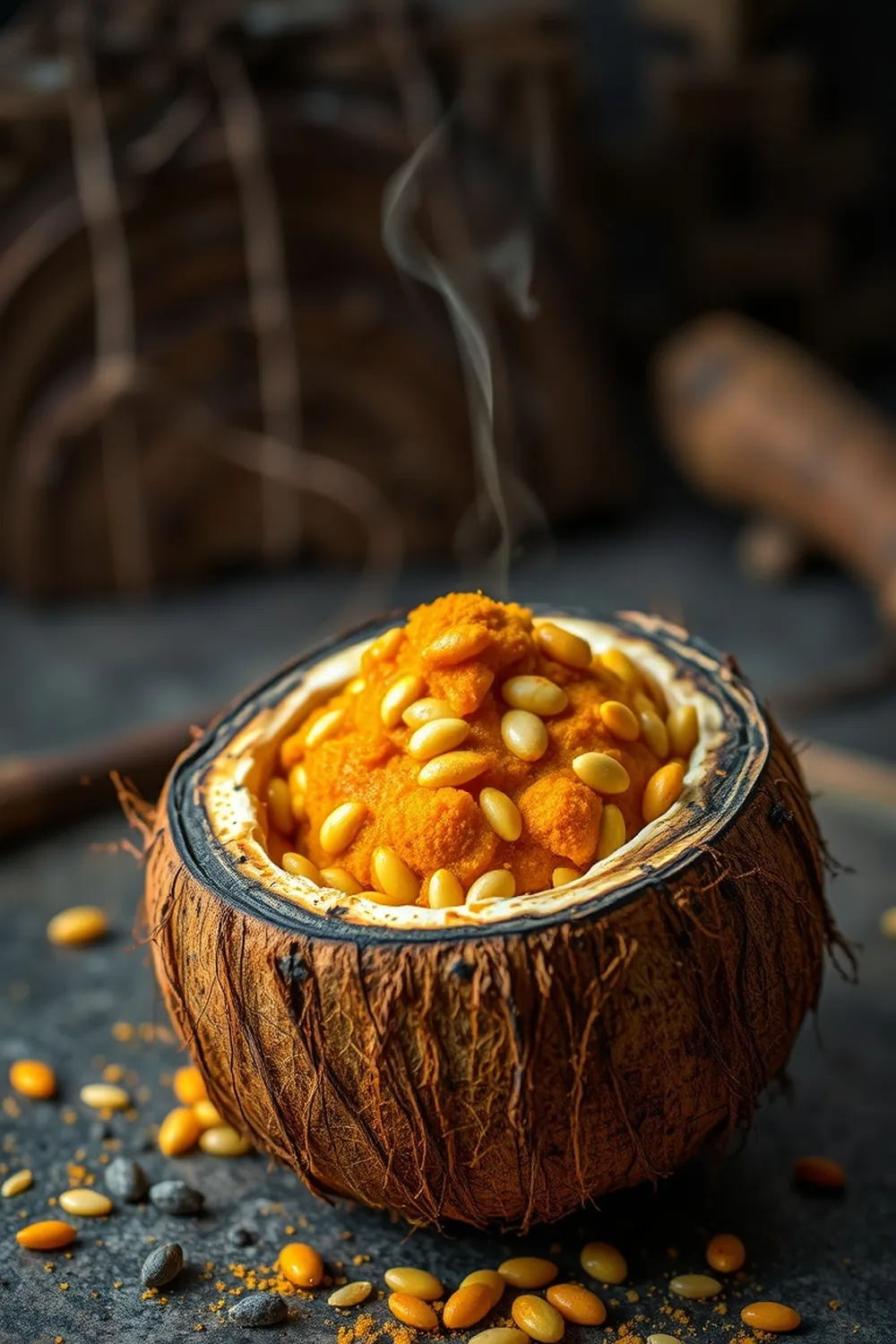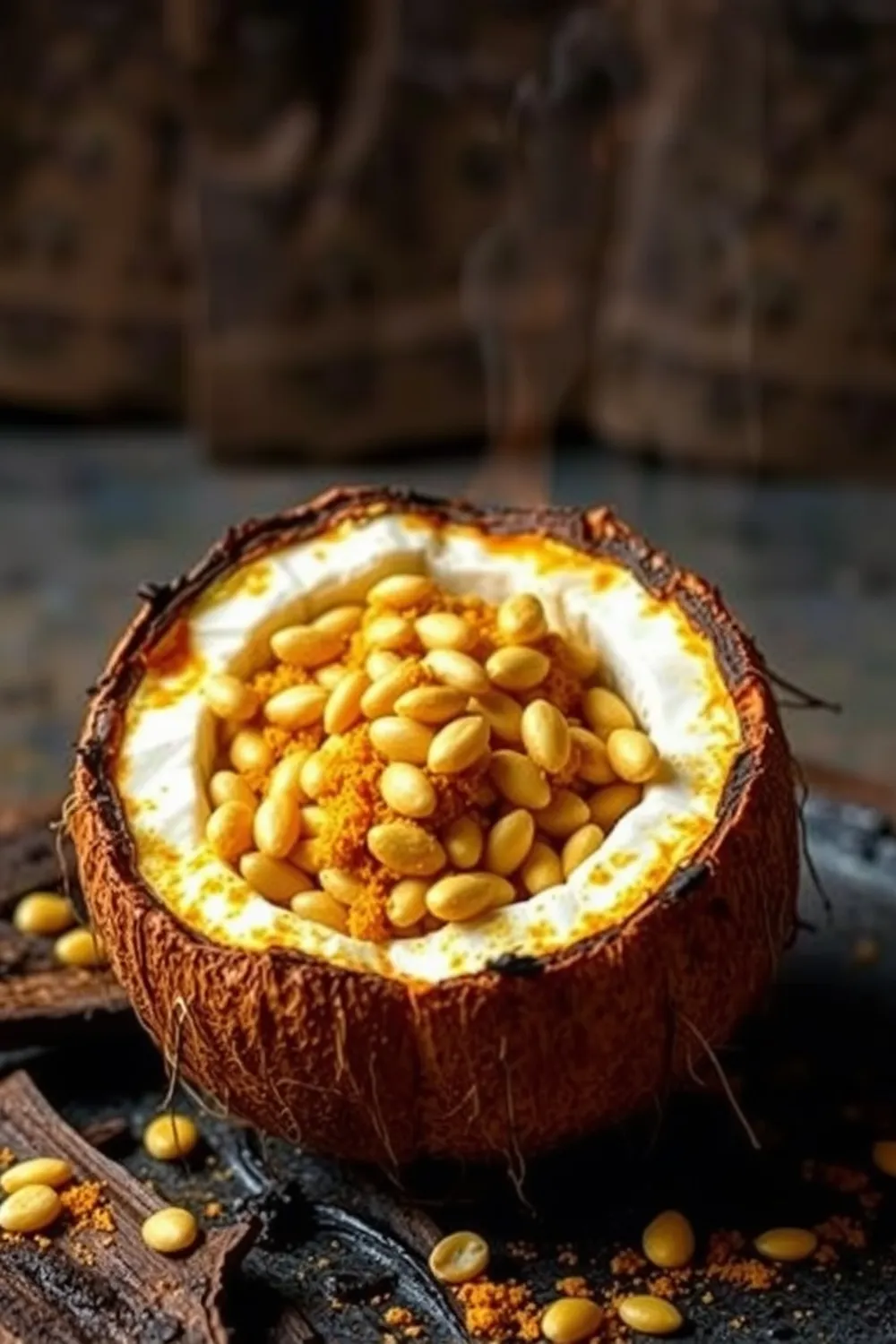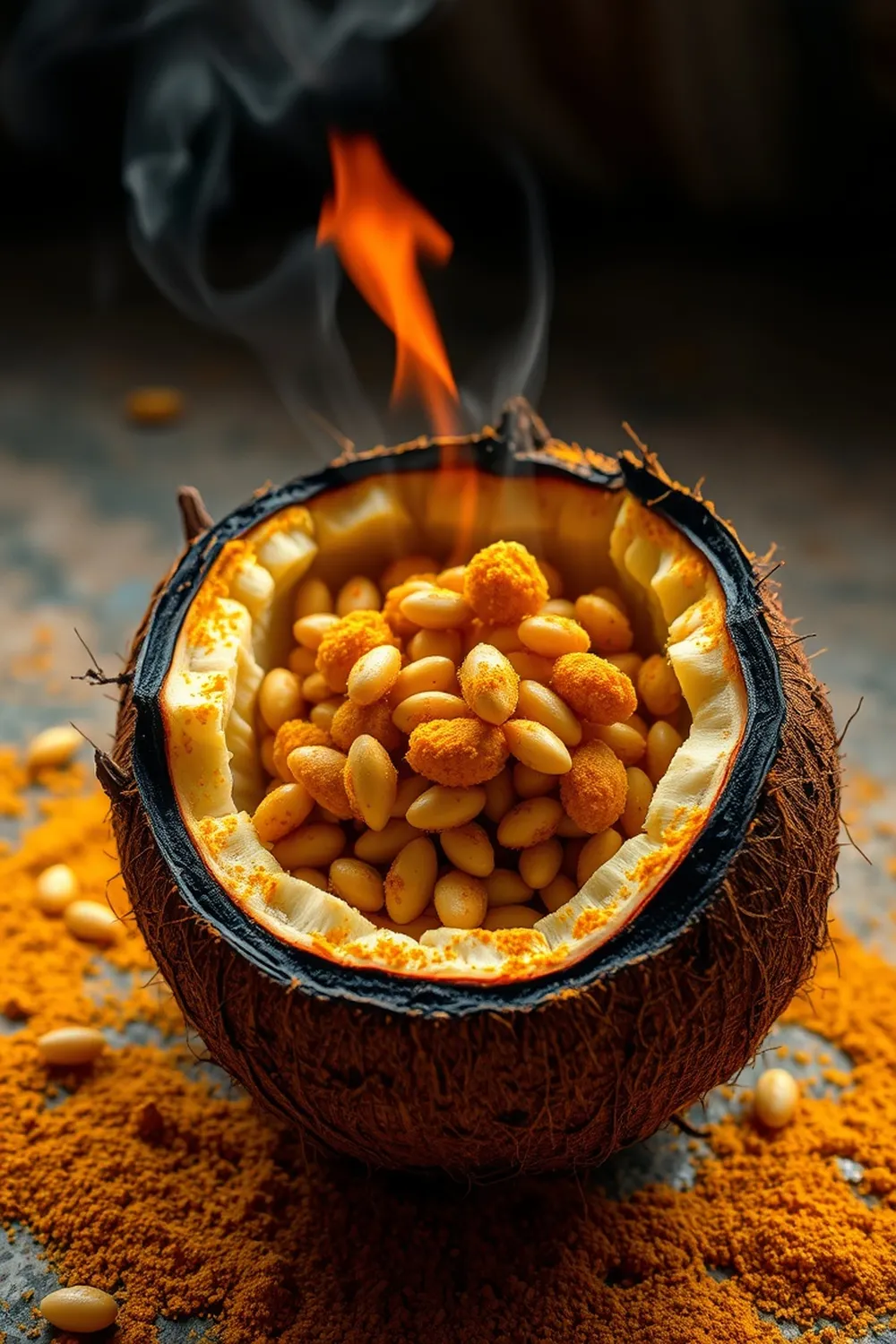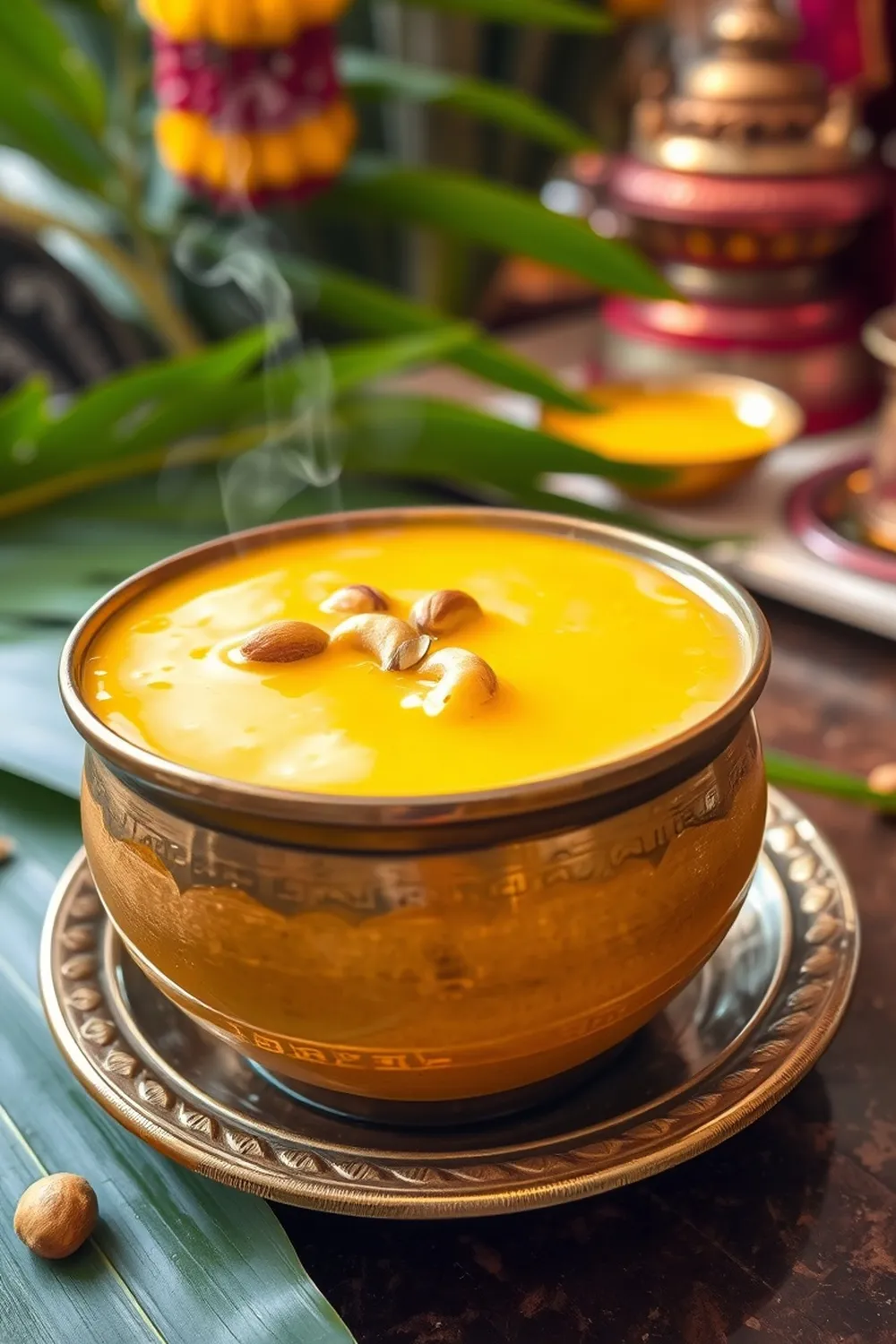- Grind raw rice, jaggery, fried gram dal, moong dal, sesame seeds, and poha into a coarse powder for the stuffing.
- Clean the coconut by removing the outer fibers and create a hole in one of its eyes using a sharp tool. Drain and reserve the coconut water.
- Stuff the ground mixture into the coconut through the hole, adding the reserved coconut water periodically to aid filling.
- Seal the hole with turmeric paste, apply turmeric powder all over the coconut, and decorate with kumkum dots.
- Skewer the coconut on a sturdy stick and roast evenly over an open flame for 10-15 minutes, until charred and cracked.
- Cool, offer to deities during Aadi Pirappu prayers, then break open to enjoy the smoky coconut and sweet stuffing.
- Calories:280 kcal25%
- Energy:1171 kJ22%
- Protein:4 g28%
- Carbohydrates:25 mg40%
- Sugar:12 mg8%
- Salt:10 g25%
- Fat:18 g20%
Last Updated on 6 months ago by Neha Deshmukh
Aadi Pirappu Coconut Recipe – Sweet Rice & Jaggery Filling
Hey everyone! If you’ve ever been around during the Tamil month of Aadi, you’ve probably heard about Aadi Pirappu – the first day of the month, celebrated with special prayers and, of course, delicious food! This Aadi Pirappu Coconut is a tradition in my family, and honestly, the smoky sweetness is just unbeatable. It’s a little bit of work, but so worth it. Let’s get into it!
Why You’ll Love This Recipe
This isn’t just a recipe; it’s a connection to tradition. The Aadi Pirappu Coconut is offered to deities as a symbol of gratitude and prosperity. Beyond the spiritual significance, it’s a truly unique treat. The combination of the charred coconut shell and the sweet, fragrant filling is something you won’t find anywhere else. Plus, the whole process is kind of magical!
Ingredients
Here’s what you’ll need to make this special treat:
- 1 whole coconut
- 2 tsp turmeric powder
- 5-6 tbsp grated jaggery (about 75-100g)
- 2 tbsp raw rice (about 20g)
- 1 tbsp fried gram dal (pottukadalai, about 15g)
- 2 tbsp moong dal (about 20g)
- 1 tbsp dry roasted sesame seeds (about 10g)
- 1 tbsp thick poha (aval, about 10g)
- As needed coconut water (from the coconut itself!)
Ingredient Notes
Let’s talk ingredients for a sec! Getting these right makes all the difference.
- Whole Coconut: A mature coconut is best – you want a good amount of flesh and water. It’s the star of the show, after all!
- Dals (Fried Gram & Moong Dal): These aren’t just for texture. They add a lovely nutty flavor and a bit of protein to the filling. Fried gram dal (pottukadalai) is especially important for that authentic taste.
- Jaggery: Jaggery is unrefined sugar, and it’s huge in Tamil Nadu cuisine. It has a beautiful caramel-like flavor that’s so much more complex than regular sugar. Grated jaggery melts easier, but you can use powdered if that’s what you have.
Step-By-Step Instructions
Alright, let’s get cooking! Don’t worry, I’ll walk you through it.
- First, we need to prep the coconut. Carefully clean the coconut, removing the outer fibers. Then, using a sharp tool (a sturdy knife or a coconut scraper with a pointed end), create a hole in one of the “eyes” of the coconut.
- Drain out the coconut water and save it! This is liquid gold, we’ll need it later.
- Now for the filling. In a dry pan, grind the raw rice, jaggery, fried gram dal, moong dal, sesame seeds, and poha into a coarse powder. You can use a spice grinder or a powerful blender, but be careful not to make it too fine.
- Time to stuff the coconut! Slowly add the ground mixture into the coconut through the hole you made. Add a little of the reserved coconut water as you go – this helps pack the filling in tightly. Keep going until the coconut is completely full.
- Seal the hole with a dab of turmeric paste (turmeric powder mixed with a little water). Then, apply turmeric powder all over the outside of the coconut. This gives it a beautiful color and is considered auspicious. Add some kumkum dots for decoration!
- Now for the roasting. Skewer the coconut onto a sturdy stick. Carefully roast it over an open flame (a gas stove works well) for about 10-15 minutes. Rotate it constantly to ensure it’s evenly charred and cracked. Be careful – it can get hot!
- Let the coconut cool completely. Offer it to your deities during Aadi Pirappu prayers. Then, the best part – break it open and enjoy the smoky coconut and sweet, delicious filling!
Expert Tips
A few things I’ve learned over the years…
- Don’t rush the roasting: Low and slow is the way to go. You want a nice char, but you don’t want the coconut to burn.
- Coconut Water is Key: Adding the coconut water to the filling is crucial for binding it together.
- Safety First: Be extremely careful when working with the open flame and the hot coconut.
Variations
Want to make it your own? Here are a few ideas:
- Festival Adaptations: Some families add a pinch of cardamom to the filling for extra fragrance during Aadi Pirappu.
- Spice Level: This recipe is naturally mild, but you could add a tiny pinch of dry chili powder to the filling if you like a little heat.
- Regional Variations: In some coastal areas of Tamil Nadu, people will use a different technique to prepare the coconut – sometimes partially scraping out the flesh before filling it.
Serving Suggestions
This is traditionally enjoyed as a prasad (blessed offering) during Aadi Pirappu. But honestly, it’s delicious any time! Share it with family and friends – it’s a great way to spread a little joy.
Storage Instructions
This is best enjoyed fresh! However, if you have any leftovers (which is unlikely!), you can store the filling in an airtight container at room temperature for a day or two. The roasted coconut shell itself doesn’t store well.
FAQs
Let’s answer some common questions:
- What is Aadi Pirappu and its significance? Aadi Pirappu marks the beginning of the month of Aadi in the Tamil calendar. It’s considered an auspicious day to worship deities and seek blessings for a prosperous year.
- Can I use powdered jaggery instead of grated? Yes, you can! Just make sure it dissolves well when you’re grinding the filling.
- What type of coconut is best for this recipe? A mature coconut with plenty of flesh and water is ideal.
- How can I ensure the coconut doesn’t crack prematurely during roasting? Rotate the coconut constantly and keep the flame at a moderate level.
- Can this be made ahead of time, and if so, how should it be stored? You can prepare the filling a day in advance and store it in an airtight container. But it’s best to stuff and roast the coconut on the day you plan to serve it.










